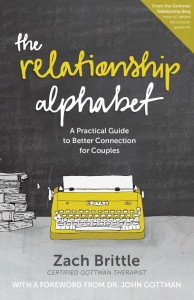Zach Brittle, a 2001 MA in Counseling graduate of The Seattle School and a Certified Gottman Therapist with more than 10 years of experience working with couples, has recently published a new book—The Relationship Alphabet: A Practical Guide to Better Connection for Couples. We’re thrilled to offer the following excerpt from the book, which you can read more about here. And don’t miss last week’s excerpt, “I is for Imagination.”
As you may remember from “A is for Arguments,” John Gottman’s research has revealed that about two-thirds of relationship problems are unsolvable. He calls these perpetual problems—the ones you’ll probably still be fussing about five years from now even though you were fussing about them five years ago. One of my favorite questions for couples is whether that statistic is discouraging or encouraging. Think about that for a second. Does it bum you out that 69 percent of your issues are not going away? Or does it give you hope?
Most couples I know are frustrated to think that most of their problems are unsolvable. It’s hard to have the same battles over and over again. My personal bias, however, is that I’m glad to know that we’re normal. In my own marriage, for example, a recurring irritant is the fact that one of us is an extrovert—life of the party, lights up a room, and all that—and the other is an off-the-charts introvert. We still haven’t figured out how to make each other go to a party the right way, but it’s nice to know that we’re not alone in our fruitless efforts.
According to Dr. Gottman, the number one thing that couples fight about is nothing. I can vouch for this, too! This past weekend, my wife and I got into a heated argument over fruit flies. Seriously. Later, when our older daughter (age 11) was explaining the argument to her sister (age 7), she said, “It’s never about the fruit flies.” If she’s right (and she is), then what’s it really about?
 I think it’s about perspective (bonus P-word). If you can accept that many of your problems aren’t going away, then you can focus on what to do about those issues when they come up. As a first step, quit trying to solve the problem. It’s wasted energy. Instead, focus on achieving perspective, empathy, and dialogue. It may help to think of the problem as a physical thing in the room, trying to distract and disgust you—kind of like fruit flies. That thing is designed to disrupt the comfort of the home with the accumulation of small annoyances that become an infestation. In the case of fruit flies, there are a bunch of home remedies (we use a glass of red wine covered with Saran wrap), but it’s always better to attack the breeding ground (usually a sink drain, just FYI). In your relationship, you can attack small annoyances every time they come up, but in order for those annoyances to fade completely, it’s critical to address the deeper problem. To do that, you have to work together.
I think it’s about perspective (bonus P-word). If you can accept that many of your problems aren’t going away, then you can focus on what to do about those issues when they come up. As a first step, quit trying to solve the problem. It’s wasted energy. Instead, focus on achieving perspective, empathy, and dialogue. It may help to think of the problem as a physical thing in the room, trying to distract and disgust you—kind of like fruit flies. That thing is designed to disrupt the comfort of the home with the accumulation of small annoyances that become an infestation. In the case of fruit flies, there are a bunch of home remedies (we use a glass of red wine covered with Saran wrap), but it’s always better to attack the breeding ground (usually a sink drain, just FYI). In your relationship, you can attack small annoyances every time they come up, but in order for those annoyances to fade completely, it’s critical to address the deeper problem. To do that, you have to work together.
That’s what dialogue is. It’s a conversation with one another—rather than at one another—that is designed to reveal the deeper meaning of a particular conflict. Dr. Gottman refers to this as the “dream within conflict.” Whenever one or both partners’ dream or hope or aspiration for the relationship is ignored, problems arise. But when those dreams are revealed and understood and respected, it creates space for the relationship to become more meaningful than the problem.
When one or both partners’ dream for the relationship is ignored, problems arise.
Dr. Gottman suggests becoming a “Dream Detective.” Try this exercise: think through some of your perpetual problems. See if you can recognize patterns within the conflicts that you’ve been rehashing without progress. Next, make up a brief, new story that may explain your own dream or position within that particular conflict. What hidden meaning are you trying to express? Is it connected to something in your childhood? Is it rooted in anxiety or fear? Does it stem from a previous relationship expectation? Once you’ve crafted your own narrative, try doing the same for your partner. Get curious about their dream or position. See if you can articulate what deeper meaning may exist for them. Try comparing notes after you’ve both done the exercise and see if it doesn’t create new dialogue around an ancient issue. This process, called “Overcoming Gridlock,” is one of Gottman’s 7 Principles for Making Marriage Work.
It bears noting that we’ve only addressed perpetual problems, which means we’re still left with another one-third of all problems. These qualify as “solvable problems,” and Dr. Gottman recommends, simply, that you solve them. There is, of course, a science and an art to this, and sometimes therapy should play a role, but identifying which problems you can solve and which require more patience is a great first step.
I’ll let you guess which one of us is the life of the party and which one is the party-pooper. Suffice to say, we gave up trying to convert one another many years ago. Now we can go out with friends and each settle into our respective roles. We’ve learned to accept and appreciate that we each get something different out of the same environment, and that’s okay. By choosing to appreciate our differences—and our dreams—we’ve been able to eliminate pointless fussing and more fully enjoy one another.
Discussion Questions:
- Do you think that about two-thirds of your conflicts are perpetual? Why do you think that?
- Think about some “small annoyances” that have led to conflict in your relationship. What might be the underlying problem or problems?
- Are the problems from question two solvable or perpetual? How can you tell the difference?
- Complete the “Dream Detective” exercise. What surprised you about your and/or your partner’s dreams for the relationship? How have these dreams been appreciated or ignored? What’s been the result?
- Think about a perpetual problem in your relationship. What might it look like to appreciate the differences at the root of the problem, without trying to change each other?

